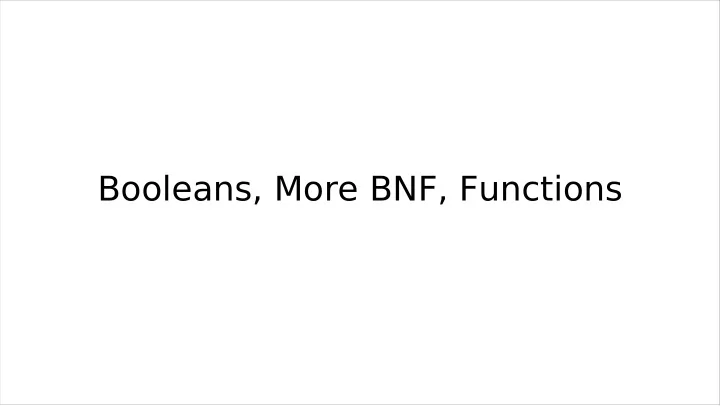

Booleans, More BNF, Functions
WiCS Women In Computer Science Dedicated to improving diversity and inclusion across gender identity in CS. Email: wics@lists.cs.brown.edu Email: wics@lists.cs.brown.edu Add yourself to the listserv: https://tinyurl.com/brownuwics
Warmup: a new kind of data • Boolean datatype • George Boole, “ The Laws of Thought” • Exactly two values • true • false • In Racket, these are written true , false • Both of these are keywords • That means you can’t use them as names • NB: so far three kinds of data: numbers, strings, booleans • Three still to come: functions , lists, (structures)
Last class • Broke Racket program text into pieces called “tokens” • Saw a standard form for definitions • Learned a way to compactly represent that standard form • Backus—Naur form, called BNF • Always written in green on slides • Some parts informal; written in italics
A small note on the behavior of definitions (demo) • This is not about what’s legal as a racket program (informally, what’s “grammatically correct”), but about what happens when you RUN a racket program • If you define the same thing twice, you get an error: (define class 17) (define class 18) generates an error!
Why am I obsessing about syntax? • Syntax: the “grammar” of the language, what it’s legal to write <prog> := <defn>* [<expr>] <defn> := ( define <name> <expr>) … • Each item on the left-hand side of the BNF for Racket will become a named thing in your Rackette assignment later in the semester! • As you’re trying to write a program, it’s nice to have a guide to what might possibly work.
Our current BNF description of Racket Read as “or” <prog> := <defn>* [<expr>] <defn> := ( define <name> <expr>) <name> := <CS17name> | <othername> <CS17name> := sequence of letters, digits, hyphens, starting with a letter, usually lowercase <othername> := token consisting of non-special characters that can’t be interpreted as a number and that isn’t a keyword <expr> := lots to fill in here!
Abstraction • Breaking things down into pieces (“tokens”, for our language) and • Giving rules for “legally” assembling pieces… • Makes describing the legal Racket programs fairly simple • An example of abstraction : • Don’t sweat the font • Don’t worry about what things mean yet • Focus on a narrow task, and ignore everything else
We can use BNF to describe other stuff • Example: tokens are single letters. No spaces allowed. <word> := <capital> <letter>* <capital> := A | B | C <letter> := a | b | c … | z • Legal “words” defined by this set of rules? Abd Bed Armchair Ccccc Activity: What’s an example of something that doesn’t fit this definition of word? cC, ABA, 14 Activity: What’s the shortest possible thing that fits this definition? (Multiple correct answers) A, B, C
Application of “matching patterns” as in BNF: Eliza • A program that breaks English sentences into words • Looks for patterns, like I hate <something>. • Here “something” can be any sequence of words • When eliza gets a pattern it recognizes, it provides a response, like Why do you hate <something>? , filling in exactly the same text. • The author of the program gets to provide a lot of patterns/ responses, and when you use the program, it feels almost as if you’re having a conversation. • What about input that doesn’t match any pattern? • We always include, as a final pattern, something that matches anything • And as a response, we use something like Tell me more.
Demo
Thoughts • Every program you write has consequences • They’re really hard to predict • Sometimes they’re hard to see because of the assumptions we make. • Who can’t use Eliza?
A BNF description for the expressions we’ve encountered so far <expr> := <name> | <num> | <misc> <num> := stuff that looks like a number <misc> := ( <op> <expr> <expr> ) <op> := + | - | * | / [NB: those last two lines will soon be replaced]
A few words from math • Racket is based on the mathematical notion of function • We’ll review that here • My notion of “function” may be different from yours • Yours may have been simplified to make it easy to teach • Mine is universally accepted by mathematicians • The difference is very small • Let’s start with “set”
Sets
Ways to describe sets: Natural language
Ways to describe sets: Enumeration
Activity
A special enumerated set
Ways to describe sets: Restriction
Recommend
More recommend